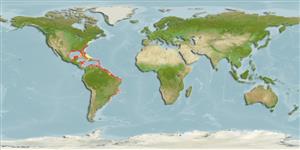Environment: milieu / climate zone / depth range / distribution range
Ökologie
seewasser; süßwasser; brackwasser demersal; tiefenbereich 0 - 75 m (Ref. 5217). Tropical; 26°C - 29°C (Ref. 36880); 41°N - 33°S
Western Atlantic: New Jersey, USA to the Antilles and Brazil.
Size / Gewicht / Alter
Maturity: Lm ? range ? - ? cm
Max length : 21.0 cm TL Männchen/unbestimmt; (Ref. 122735); common length : 15.0 cm TL Männchen/unbestimmt; (Ref. 5217); max. veröff. Gewicht: 99.40 g (Ref. 122735)
Rückenflossenstacheln (insgesamt) : 0; Rückenflossenweichstrahlen (insgesamt) : 74 - 84; Afterflossenstacheln: 0; Afterflossenweichstrahlen: 52 - 63.
Occurs in shallow muddy bottoms from the coastline to 75 m depth; also in brackish estuaries and hypersaline lagoons (Ref. 5217). Inhabit mainly coastal waters and tidelands, but abundant in waters very near the sea to a few meters elevation with wholly freshwater ichthyofauna (Ref. 36880). Feeds mainly on zooplankton and zoobenthos (Ref. 13196). Taken with beach nets (Ref. 5217).
Distinct pairing (Ref. 205). Oviparous (Ref. 101737). Females produce numerous eggs in multiple spawnings during a prolonged spawning period (Ref. 101737).
Robins, C.R. and G.C. Ray, 1986. A field guide to Atlantic coast fishes of North America. Houghton Mifflin Company, Boston, U.S.A. 354 p. (Ref. 7251)
IUCN Rote Liste Status (Ref. 130435: Version 2024-2)
Bedrohung für Menschen
Harmless
Nutzung durch Menschen
Fischereien: weniger kommerziell
Tools
Zusatzinformationen
Download XML
Internet Quellen
Estimates based on models
Preferred temperature (Ref.
123201): 22.5 - 28, mean 25.5 °C (based on 608 cells).
Phylogenetic diversity index (Ref.
82804): PD
50 = 0.5000 [Uniqueness, from 0.5 = low to 2.0 = high].
Bayesian length-weight: a=0.00589 (0.00488 - 0.00711), b=3.14 (3.09 - 3.19), in cm total length, based on LWR estimates for this species (Ref.
93245).
Trophic level (Ref.
69278): 3.6 ±0.58 se; based on food items.
Generation time: 2.6 ( na - na) years. Estimated as median ln(3)/K based on 1
growth studies.
Widerstandsfähigkeit (Ref.
120179): hoch, Verdopplung der Population dauert weniger als 15 Monate. (K=0.42; Fec=6,009 (batch fecundity)).
Fishing Vulnerability (Ref.
59153): Low to moderate vulnerability (28 of 100).
